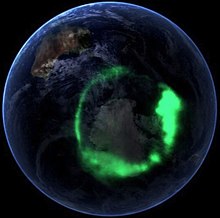Imager for Magnetopause-to-Aurora Global Exploration
| IMAGE (Explorer 78) | |
|---|---|

|
|
| Type: | Research satellite |
| Country: |
|
| Operator: |
|
| COSPAR-ID : | 2000-017A |
| Mission dates | |
| Dimensions: | 536 kg |
| Begin: | March 25, 2000, 20:34 UTC |
| Starting place: | Vandenberg AFB , SLC-2W |
| Launcher: | Delta 7326-9.5 D277 |
| Status: | Out of service since December 18, 2005 Reception of radio signals from January 20, 2018 |
| Orbit data | |
| Rotation time : | 853.8 min |
| Orbit inclination : | 94.0 ° |
| Apogee height : | 45,426.9 km |
| Perigee height : | 1458.3 km |
Imager for magnetopause-to-Aurora Global Exploration ( IMAGE , and Explorer 78 ) is a research satellite of NASA , who as Explorer mission of MIDEX class ( middle-sized Explorer ) the effects of the solar wind to the magnetosphere examined. He became known when a Canadian radio amateur was able to re-establish contact with the probe believed to be dead in 2018, more than ten years after the end of the mission.
Mission history

The satellite, approved in 1996, was built by Lockheed Martin Missiles & Space in Sunnyvale . On March 25, 2000, a Delta 7326 rocket brought the satellite from Vandenberg Air Force Base into a highly elliptical polar orbit with a perigee of 1,400 km and an apogee of 8.2 Earth radii.
IMAGE used imaging measurement methods for neutral atoms, ultraviolet radiation and radio waves to carry out the following investigations:
- Identification of the main mechanisms for the injection of the plasma into the magnetosphere during magnetic storms and partial storms .
- Investigation of the direct reaction of the magnetosphere to changes in the solar wind.
- Investigation of how and where the energization, the transport and finally the loss of the magnetospheric plasma takes place during magnetic storms and partial storms.
After 5.8 years of successful operation, the IMAGE satellite stopped responding to radio signals on December 18, 2005. The cause of the failure was probably a fault in the energy supply of the transponder .
While searching for traces of the ZUMA mission, Canadian radio amateur Scott Tilley discovered on January 20, 2018 that the satellite was transmitting again. Long-term shading of the solar cells may lead to the batteries being drained and then restarting the on-board computer. On January 30, telemetry data from the probe could be received. Unlike previously assumed, the satellite is currently working on the A-side of the redundant on-board computer, which is believed to be defective . The condition of the probe is good, the battery is fully charged. An attempt should now be made to reactivate the scientific instruments. To do this, the old software must first be adapted and suitable hardware found.
On February 22, 2018, the IMAGE signal initially became unstable and was completely lost two days later. This gradual failure of the signal did not resemble the sudden complete failure of 2005.
On May 9, 2018, contact with IMAGE was resumed. A lot of commands were sent to find out the status of the satellite. The satellite received only a few of the commands, contact was broken again in August 2018 and could not be re-established.
Currently (October 2019) no contact could be made. NASA therefore declared the mission over.
construction
The IMAGE satellite has the structure of an octagonal prism from which two axial arms and four radial antennas extend. Solar cells on the side surfaces secure the energy supply. IMAGE is spin stabilized .
The scientific equipment consists of the following instruments:
- A set of three neutral atom imager ( NAI , engl. For neutral atoms imaging tools ) delivers energy and composition resolution images at energies of 10 eV to 200 keV. The time resolution is 300 seconds.
- Two imaging ultraviolet instruments cover the wavelength range from VUV radiation (20–180 nm) to extreme ultraviolet radiation (30.4 nm).
- The Radio Plasma Imager (RPI) is a low power radar that operates in the radio frequency range of 3 kHz to 3 MHz. The plasma resonance frequencies of the terrestrial magnetosphere are in this frequency range. RPI consists of two ten meter long axial booms and four 250 meter long radial antennas.
Web links
- Video of Northern Lights captured by IMAGE ( MOV ; 1.3 MB)
- NASA: IMAGE website (English)
- IMAGE in the NSSDCA Master Catalog (English)
- IMAGE at Gunter's Space Page (English)
- scinexx .de: "IMAGE" is alive! 29th January 2018
Individual evidence
- ↑ Orbit data according to IMAGE Satellite details 2000-017A NORAD 26113. In: N2YO.com. Accessed January 28, 2018 .
- ↑ IMAGE Failure Review Board Final Report, Executive Summary, September 19, 2006 ( PDF )
- ^ Paul Voosen: Amateur astronomer discovers a revived NASA satellite . In: Science . January 26, 2018, doi : 10.1126 / science.aat1319 .
- ↑ Scott Tilley: NASA's Long Dead 'IMAGE' Satellite is Alive! In: Riddles in the Sky. January 21, 2018, accessed January 27, 2018 .
- ^ A b Miles Hatfield, Rob Garner: Latest Data From IMAGE Indicates Spacecraft's Power Functional. In: NASA Goddard Space Flight Center . February 5, 2018, accessed February 6, 2018 .

